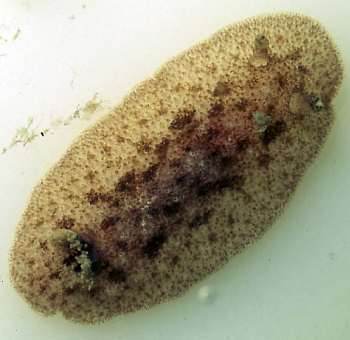
Jorunna alisonae
Marcus, 1976
Order: NUDIBRANCHIA
Suborder: DORIDINA
Superfamily: EUDORIDOIDEA
Family: Dorididae
DISTRIBUTION
Known only from Hawaii
PHOTO
Maro Reef, Northwest Hawaiian Islands. on dead coral head, 10 meters. Length: 25mm. 14 Sept. 2002. Photo: Keoki Stender
Mantle covered in small spiculate tubercles [caryophyllidia], giving the mantle a 'furry' appearance. Colour translucent yellowish brown with darker brown patches. Previously identified by Kay & Young (1969) with the European Jorunna tomentosa. Marcus (1976) in a revision of the genus recognised this species from Hawaii as a new species which she named Jorunna alisonae noting that it differed from J. tomentosa in having jaw rodlets, and in relatively minor differences to the genital armature. It is possible that this species is a widespread Indo-West Pacific species and so may have an earlier name. Further studies on this genus are needed to clarify the nonemclature.
References:
• Kay, E.A. & Young, D.K. (1969) The Doridacea (Opisthobranchia: Mollusca) of the Hawaiian Islands. Pacific Science, 23(2): 172-231. [as Jorunna tomentosa.]
• Marcus, Ev. (1976) On Kentrodoris and Jorunna (Gastropoda Opisthobranchia). Boletim de Zoologia, Universidade de Sao Paulo, 1: 11-68.
Rudman, W.B., 2003 (November 11) Jorunna alisonae Marcus, 1976. [In] Sea Slug Forum. Australian Museum, Sydney. Available from http://www.seaslugforum.net/find/jorualis
Related messages
Jorunna alisonae? from Hawaii
November 13, 2003
From: Keoki Stender

Hi Bill,
Is this Jorunna alisonae? Collected during the NOW-RAMP 2002 expedition to the Northwest Hawaiian Islands.
Date: Sept. 14, 2002
Location: Maro Reef
Habitat: Dead coral head, 10 meters
Length: 25mm
Thanks,
Keoki Stender
fishpicshi@yahoo.com

Dear Keoki,
From the spiculate mantle I suspect this is a species of Jorunna and from its colour it certainly fits what Marcus described as J. alisonae. However as I discuss on the Fact Sheet we still need to look more closely at the genus throughout the Indo-West Pacific before we can be sure how many species there really are. It is possible that this Hawaiian animal is a widespread Indo-West Pacific species, and if so, it may already have a name
Best wishes
Bill Rudman
